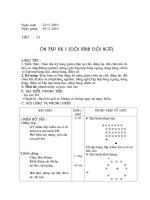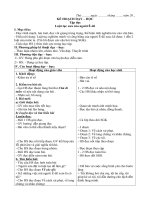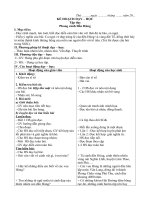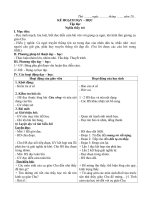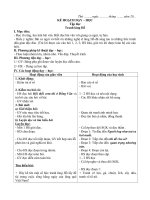Giáo án Tiếng anh 6 thí điểm cả năm hay.
Bạn đang xem bản rút gọn của tài liệu. Xem và tải ngay bản đầy đủ của tài liệu tại đây (721.3 KB, 167 trang )
Preparing date:14/ 8/ 2018
Teaching date: 15/ 8/ 2018
PERIOD 1: Introduction
A. Objectives:
By the end of the lesson, Ss will be able to know the content of the lesson and the
structure of new textbook and know how to learn English
B. Method:
Matching, pair work, Communicative approach
C. Teaching ads:
Course book, Workbook, lesson plan.
D. Procedures:
Teacher’s activites
Ss’ activities
I. warm up
* Chatting
T- whole class
- introduce her self and make
friends with students.
II/ New lesson :
* The student’s book :
- T introduce the student’s book.
Ss pay attention
_ Help Ss know the structure of
textbook, workbook and
component of each units.
_ T introduce workbook.
_ T introduce the component of
Ss pay attention
Ss pay attention
The contents
1. Students’ books
+ 12 topic – based Units, each
covering 8 sections to be
taught in seven 45 minute
lessons.
+ 4 Reviews, each providing
revision and further practice
of the previous three units, to
be dealt within two periods.
+ Glossary : Giving meaning
and phonetic transcription of
the new words in the units.
2. The workbook :
_ The workbook mirrors and
reinforces the content of the
Student’s book. It offers :
+ Further practice for the
language and skills taught in
class and four additional tests
for students’ self assessment.
* CD
each unit
III/ How to study English 6:
- T guides Ss to know how to
study English 6.
- Whole class
1/ Reading skills : Skimming
for gist and scanning for details
Pay attention
_ Reading aloud, practicing the
pronunciation and intonation.
_ Understand the meaning of
new works or guessing
unfamiliar words in a logical
context.
_ Guessing what the text is
about, what words will appear
in the text.
2/ Speaking skill : Spoken
interaction and spoken
production.
_ Pronunciation
_ Repetition
_ Pair work / group work class
presentation
3/ Listening skill :
_ Before listening : Predict the
listening content, introduce the
new language or vocabulary
_ After listening : Show
listening comprehension in front
of the class, provide a follow –
up spoken/written activity.
4/ Writing skill :
_ Before writing : Understand
why they write and use the
language input to express the
idea.
_ While writing : Work
independently under the
3. The component of each
unit :
+ Section 1 : Getting started
+ Section 2 : Closer look 1
+ Section 3 : Closer look 2
+ Section 4 : Culture and
communication
+ Section 5 : Skill 1
(Reading, speaking)
+ Section 6 : Skill 2
(Listening, Writing)
+ Section 7 : Looking back
and project.
teacher’s guideline
_ After writing : Consolidate the
writing skills through a follow –
up activities.
5/ Pronunciation :
_ Phonetics (sounds in isolation
and in the context) : rhymes,
chants and songs
6/ Vocabulary :
_ Understand, memorize and
use words appropriately in the
specific contexts.
7/ Grammar :
_ Use correct grammatical
patterns to express the ideas in
Write down in
specific context.
notebook
III. Homework
- Write new words then draw a
picture next to the word
- Prepare next lesson : unit 1
(Getting started)
Preparing date:14/ 8/ 2018
Teaching date: 17/ 8/ 2018
UNIT 1: MY NEW SCHOOL
Period 2: Getting Started - A special day
A. Objectives:
By the end of the lesson, students can:
• use the lexical items related to the topic ‘My new school’
• use the present simple and the present continuous
• talk about school objects and school activities
B. Language Focus:
1. Vocabulary: the items related to the school.
2. Structures: The present simple and the present continuous tense.
C. Method:
Matching, pair work, Communicative approach
D. Teaching ads:
Course book, CD player, picture.
E. Procedures:
Teacher’s activites
Ss’ activities
The contents
I. warm up
* Brainstorming.
– Devide the class into 2 teams
Cats and Dogs.
Play in team
- Give the topic “ School
things”
– Each member of a team will
write one name of the school
objects in turn in 1 minute
– Who writes more words
correctly and faster will
be the winner.
I. New words
II.Presentation
- (to) knock:
1. Pre teach
- Teacher uses different
- be excited about:
techniques to teach vocab
phấn chấn, phấn khích
- Repeat in
(situation, realia)
- uniform : bộ đồng phục
chorus and
- (to) knock (mine)
- wear = put on: mặc, đội
individually
- be excited about
- smart: bảnh bao
- Copy all the - calculator: máy tính
(example)
words
- uniform ( explaination)
- 'compass: la bàn
- wear = put on: ( mine)
- 'rubber = eraser : cục tẩy
- smart (synomyn)
- calculator: (visual)
- 'compass: (visual)
- 'rubber (synonym)
* Checking VOC: ROR
2. Elicit the dialogue
-Ask Ss to look at the picture on
page 6
? Who are they?
? What is Phong doing?
? Who are Vy and Duy?
? Why is it a special day for
them?
- We are going to listen and
read a dialogue about Phong,
Vy and Duy's special day.
- Play the recording twice.
? Listen and read then check
your answer for the last
question.
III. Practice
Act 1. True or False (1a P7)
– So you have listened to
the dialogue, let’s see if
you can understand it
well by deciding whether
these statements are
true or not.
– I would like you to do
individually then you can
discuss with your partner
next to you.
- get Ss to run through the
statements.
? Work individually.
? Share answers with your
partner.
- Teacher gives feedback.
2. Gueesing the meaning (1b.
P7)
– You must now understand the
- Whole class
- They are Phong, his Mum,
Vy and Duy.
Answer the
questions
- He is having breakfast.
- They are Phong's
schoolmates.
- Because it is their fisrt day
a the new school.
- Listen and
read
2. Listen and read
1a. Are these sentences true
or false?
Key:
1. T 2. T 3. F 4. T
5. F
Work
individually
- Pair-work
b. Find these expressions in
the conversation. Check what
they mean
1. Oh dear: used to express
surprise (negative)
2. You’ll see: “You’ll find
dialogue, let’s do some more
study to find the synonyms to
these expressions.
? Refer back to the conversation
to find the expression.
– Now, let’s check; Oh dear –
When do you use this?
– True, you use this to
express a negative
surprise,
for example, you
carelessly break a cup or
a bowl,
your mum can say this to
you.
– How about ‘You’ll see’?
Correct, it means You will
find out.
– And of course the
expression ‘Come in’
everybody
must know, we want to
invite sb in.
– And the last one ‘Sure’
means Certainly or Of
course.
- Ask Ss to role-play the short
conversations in pairs before
creating short role-plays.
- Let more able Ss try to extend
the conversation
Act 3. Match the
words with the school
things
Game: Pelmanism’
- Ask Ss to match the words
with the school things.
– I have two sets of cards, one
includes pictures of
school things and the other
- Whole class
out”
3. Come in:used to invite sb
in
4.Sure: used to say “yes”/
alright”
c. Create short role-plays
with the expressions. Then
practice them.
Pair work
Examples:
T: Oh dear, I forgot my ruler.
Ann: Don’t worry, you can
use mine.
T: Thank you
3. Match the words with the
school things. Then listen
and repeat.
Play the game
in teams.
Key:
1–b 2–e 3–j
4–d 5–c 6–i
7–f 8–a 9–g
10 – h
Whole class
work
* What other things do you
includes their names.
Let’s match as fast as possible
to have the correct
pair. Are you ready?
- Play the recording. Ss listen
and repeat.
- Then let them practice saying
the names of school things
( explain the meaning if
necessary, eg, use visual aids in
the classroom.)
- Tell Ss to look around the
class. Ask what they see around
them/ what they have.
- Let Ss to practice the words,
and make up the sentences with
the words it there is time.
IV. Production
Act 2. Listen and read the
poem
- Play the recording.
- Let Ss read the poem in the
right intonation and rhythm and
check their understanding of the
poem.
- Ask Ss to write a poem about
their partner, then read them
poem aloud.
V. Homework
- Write new words then draw a
picture next to the word
- Prepare next lesson
(A closer look 1)
have in your class?
Example:
Table, desk, noticeboard,
picture, flowers…
Work
individually
2. Listen and read the poem.
- Individual
work
Write down in
notebook
Example:
Khanh is going to back to
school today.
His friends are going back to
school, too.
His new school year starts
today.
He’s got a new bike.
His friends are on their way.
…
Preparing date: 18/8/2018
Teaching date: 20/ 8/ 2018
UNIT 1: MY NEW SCHOOL
Period 3: A closer look 1 – Vocabulary.
A. Objectives:
By the end of the lesson, students can:
• use the lexical items related to the topic ‘My new school’
• pronounce correctly the sounds /əʊ/ and /ʌ/ in isolation and in context
• use the combinations: to study, to have, to do, toplay + Noun
B. Language Focus:
1. Vocabulary: the subjects in the school.
2. Structures:
o The present simple.
o The combinations: to study, to have, to do, to play + Noun.
C. Method: Matching, pair work, Communicative approach
D. Teaching ads: Course book, CD player, picture.
E. Procedures:
Teacher’s activities
Ss’ activities
The contents
I. warm up
1. English - photo 1
* Pelmanism
2. Physics - photo 2
- Prepare 12 cards with the
3. History - photo 3
names of the school subjects
and their photos.
Play the game in 4. Music – photo 4
5. football - photo 5
- Divide class into two teams.
teams.
6. homework – photo 6
- each member from teams will
choose a pair of cards. If they
‘re suitable with each other,
he/she will get a star. If not,
he/she has to put them back
their first position.
- Which team has more stars
will be winner.
II. Presentation
New words:
- physics (n): môn Vật Lí
1. Pre teach.
- elicit some new words by
different techniques.
1. physics : (visual)
2. judo : (visual)
3. school lunch : (visual)
4. science : (What kinds of
subjects do we put Maths,
Physics,or chemistry in?)
5. vocabulary: (examples)
* Checking: Rub out and
remember
III. Practice
Activitiy 1
- Play the recording.
- Play it again and pause for Ss
to repeat each word.
- Correct their pronunciation.
Activitiy 2
-Ask Ss to put the words in 1
into groups.
- Then check their answer.
- Explain to them which words
go with each verb
Activitiy 3
-Tell Ss to do the task
individually.
-Call some Ss to write on the
board
- Then check their answers
- Repeat in
chorus and
individually
- judo (n): võ Judo
- school lunch (n.phr.):bữa
trưa ở trường.
- science (n): khoa học
- vocabulary: từ vựng
- Copy all the
words
The whole class
read the words
Listen and repeat
II. Practice
1. Listen and repeat the
words.
to play
to do
to have
to study
Work in pairs
Work
individually
+ Noun
2. Put the words in 1 into
groups.
Key:
play
football, music
do
homework, judo, ex
have
school lunch, lesso
study
Physics, English, h
3. Put one of these words in
each blank.
Key:
1. Homework
2. Football
3. Lessons
4. Judo
5. science
Activity 4:
-Ask Ss to write sentences
about themselves in their
notebooks, using the
combinations above.( They can
write as many sentences as
possible)
Activity 5:
- Ask Ss to practice the
sounds /əʊ / and /ʌ/. Play the
recording and ask Ss to listen
and repeat.
- Play the recording twice.
- Let Ss check their answers in
groups.
- Call some Ss to write their
answers on the board.
- Correct the mistakes.
IV. Production
-Play the recording. Let Ss
repeat sentences.
- Help them recognize the two
sounds, then underline them in
the sentences
*Write
Work
individually
Listen and repeat
sentences
about
yourself
E.g.: I/ We have English
lessons on Tuesday and
Thursday
4.Pronunciation /əʊ/ and /ʌ/
* Sound /əʊ /:
Rode, don’t ,hope ,
homework post
* Sound /ʌ/:
Some,Monday, month,
come one
Listen and put the
1. They are going to open a
words into right
new library.
colunms.
2. I’m coming home from
school.
3. His brother eats lunch in
the school canteen.
4. The new school year stars
- Listen and
repeat
next month.
5. My brother is doing his
- Individual work
homework.
6.He goes to the judo club
every Sunday
V. Homework
-Practice vocabulary and
pronunciation of 2 sounds/əʊ /
and /ʌ/ again
Write down
-Make 5 sentences with new
homework
words
-Prepare A CLOSER LOOK 2
Preparing date: 18/ 8/ 2018
Teaching date: 22/ 8/ 2018
UNIT 1: MY NEW SCHOOL
Period 4: A closer look 2 – Grammar.
A. Objectives:
By the end of the lesson, students can:
• use the present simple and present continuous tenses
• talk about school activities, subjects and what students do at school
B. Language Focus:
Structures:
o The present simple and present continuous tense.
C. Methods: pair work, Communicative approach
D. Teaching ads: Course book, picture.
E. Procedures:
Teacher’s activites
Ss’ activities
The contents
I. warm up
*Chain game
- T asks Ss some questions
about their daily activities
?what do you often do in the
morning?
- play the game
? what do you often do at
in groups of 6
school?
?what do you often do after
S1: Every day I wake up
school?
S2: Every day I wake up and I
- Guide Ss to play chain game
brush my teeth.
beginning with “ Every day I
S3: Every day I wake up , I
wake up….”
brush my teeth and I wash my
face
II.Present simple tense
- elicit the present simple
tense:We have just played a very
interesting game; canyou tell
me which tense has just been
used ? Why do we use that?
( talk about our daily routine.)
- Ask Ss to read some examples
Eg1: I brush my teeth every
morning.
Tuan brushes his teeth every
morning.
Eg2: I play soccer every
afternoon.
Tuan plays soccer every
afternoon.
=> So we need to remember to
add S or ES when the subject is
HE or SHE or IT.
- Ask Ss to read Remember on
Page 9 and take out the
formation.
- Check: Form – Meaning – Use
– Pronunciation
1. We say Tuan brush or Tuan
brushes? / We say Do
Tuan go? or Does Tuan go?
2. When do we use the Present
Simple Tense?
3. We say /dʌz/ or /dʌ/?
Activity1 : Write the correct
form of the verbs.
- Let Ss to do the task
individually.
- Correct their answers.
- Allow Ss to write the
sentences in their notebooks,
referring to the interview.
- Call 1 or 2 Ss to write on the
- answer T’s
questions
I- The present simple
1- Usage: We use the present
simple to talk about things in
general .We also use it to say that
something happens all the time
or repeatedly.
Read the
examples
Work
individually
2- Formation:
Positive:
I/ you/ we/ they + V (work,
stydy)
He/ she /it + V-s/ V-es. (works,
studies)
Negative:
I/ you/ we/ they + don’t / do not
+V
He/ she /it + doesn’t/ does not +
V
Copy down
- Individual
work
- Individual
work
Questions and short answer:
Do I/ you/ we/ they + V?
Yes, I/ you/ we/ they do.
No, I/ you/ we/ they don’t.
Does He/ she /it + V?
Yes, He/ she /it + does.
No, He/ she /it + doesn’t.
* Practice:
1. Write the correct form of the
verbs.
1. Has
2. Do you have
3.Love
4. Does Vy walk
5. Ride
6. Teaches
7. Doesn’t play
8. Reads
8. Go
9. Do
2. Correct the sentences
according to the information in
(1) above.
Key:
board, check their answers
sentence by sentence.
- Pair-work
- Ask Ss to take turns to ask
questions and give answers.
- Go around and correct their
mistakes or give help when
necessary.
III. The present continuous.
- Ask Ss to refer to the
conversation in Getting started.
Focus on the verbs used in the
present continuous.
? Now, everyone, look at this
picture again and tell
me: ?What is Phong doing?
- he is having breakfast.
? How about his mother? What
is she doing?
- She is talking to Lan and Vy.
?So what tense have we just
used? – Present Continuous
- Ask Ss to take out the
formation, then check Form –
Meaning – Use – Pronunciation
Duy lives near here.
Duy likes/loves his new
school.
3. Vy and Duy ride to school.
4. Mr Quang teaches Duy
English.
5. At break time, Phong reads
in the library.
3. Make questions then interview
your partner.
Key:
1. Do you ride your bike to
school?
2. Do you read in the library at
the break time?
3. Do you like your new
school?
4. So your friends go to school
with you?
5. So you do your homework
after school?
1.
2.
- Individual
work.
Anser the
questions
Activity 5. Complete the
sentences with the correct form Work
individually
of the verbs.
- Have Ss study the example
II. The present continuous:
1-Usage:We use the present
continuous to talk about
something which is happening at
or around the time of speaking
2- Formation:
Positive:
S+ am /is/ are + V-ing
Negative
S + am not/ isn’t/ aren’t+ V-ing
Questions and short answers
Am / Is/ Are + S + V-ing ?
Yes, S + am /is/ are.
No, S + am not/ isn’t/ aren’t.
5. Complete the sentences with
the correct form of the verbs.
1. Am not playing
first.
- Ask Ss to give the correct form
of the verbs.
- Ask Ss to say why to use the
tense in each sentence.
Activity 6. Choose the correct
tense of the verbs.
- Help Ss to know the symbols
to recognize these tenses:
+The present simple goes with
now, every day, on Tuesday….
+ The present continuous goes
with at the moment, atpresent,
Look! …
- Ask Ss to choose the correct
tense of the verbs.
- Ask Ss to discuss any common
errors and provide further
practice if necessary.
IV Production
-Have Ss do the task by
themselves. Then they can
discuss their answers with a
partner before discussing with
the class
a. Underline things that often
happen or are fixed. Then
underline things that are
happening now.
- call two Ss to go to the BB. S1
write the Verbs in present
simple. S2 writes the verbs in
present continuous.
b. Help Ss compare Vy’s first
week with theirs individually.
They can write in their
notebooks. Then T calls them to
read out theirs sentences.
- Corrects their mistakes.
V- Homework:
- Complete Ex 3, 7 in notebook
Are studying
Aren’t doing
Am having
5.Are riding
2.
3.
4.
- Pair-work
6. Choose the correct tense of
the verbs.
1. Are having
2. Wears
3. Starts
4. Is watching
5. Are skipping
Write down
- work
individually
- work
individually
Two Ss do on
BB
Write down
7. Read Vy’s email to her friend.
E.g
- Both Vy and I are having an
interesting first week
- I wear my uniform every day,
but Vy wears her uniform only
on Mondays and Saturdays
- Do Exercises in WB: 4(P5),
1,2 (P6)
-Prepare communication
Preparing date:18/ 8 /2018
Teaching date:24/ 8/ 2018
UNIT 1: MY NEW SCHOOL
Period 5: Communication
A. Objectives:
By the end of the lesson, students can:
• use the lexical items related to the topic ‘My new school’
• ask appropriate questions when making new friends at a new school
• know what qualities a good friend should have
B. Language Focus:
1. Vocabulary: pocket money, remember, share, help, classmate.
2. Structures: The present simple tense.
C. Methods:
pair work, Communicative approach
D. Teaching ads:
Course book, CD player, pieces of paper.
E. Procedures:
Teacher’s activities
Ss’ activities
The contents
I. Warm up
* Game: ‘Are you my best
* suggested questions
friend?’
1. What color does Tuan like
- Call a pair of close friends in
Play the game in
the best?
the class ( Student A and student pairs
2. When is Tuan’s birthday?
B)
3. How many brothers and
- Give some questions. Student A
sisters does Tuan have?
writes the answers on a piece of
4. Which class at primary
paper, student B speaks out the
school does Tuan go to?
answers. If their answers are the
5. What is Tuan’s favorite
same, they are really good
song?
friends, if not, they try their best
to get to know each other better.
II. Presentation
*. Pre teach
- Have Ss guess the meaning of
vocabulary.
-Tell Ss that this vocabulary will
appear in the tasks that follow
-Then T asks Ss to answer these
questions:
*How do you often make
friends?
*What do you often say when
you first meet a new friend?
* What questions do you
often ask? (name/ age/ hobby)
III. Practice
1. Game: Making friend.
-Individually Ss read and tick the
questions.
-Then T lets them discuss in
groups.
-T may ask why or why not they
ticked this or that question.
-Allow Ss some time to write
questions on a piece of paper,
share them with the class or
group
2. Friendship quiz
-First, ask Ss to give qualities of
a good friend in class (adjective).
- They can give as many words
as possible
E.g.: friendly, generous,
helpful, cheerful, etc.
-Divide the class into groups of 4
or 5. Ss take turns to interview
the other members, using the
questions.
- Encourage Ss to give nice
- Whole class
I. Vocabulary
- pocket money: tiền tiêu vặt
- to remember: nhớ
- to share : chia sẻ
- to help: giúp đỡ
- classmate: bạn cùng lớp
II. Practice
- Answer
Individual work
1. Game: Making friend.
2. Friendship quiz Example:
- Friendly
- Generous
- Helpful
- Cheerful
- trustful
- Kind
- caring
- …
- Group-work
Present to the class about your
good friends and why they are
good friends.
sentences about
friendship:“Friends are
- Group-work
forever……..
IV.Production
-Choose some Ss to present to
the class about their good friends
and why they are good friends
- Whole class
(avoid talking about someone
who is considered “not a good
friend”……………
V. Homework
- Write five sentences about your
Write down
good friends.
-Prepare SKILLS 1.
Preparing date: 26/8/2018
Teaching date: 27/8/2018
UNIT 1: MY NEW SCHOOL
Period 6: Skill 1
A. Objectives:
By the end of the lesson, students can:
• read for specific information about schools
• talk about different types of schools
• talk about the school that they like or don’t like and the reasons for that
B. Language Focus:
1. Vocabulary: boarding, surrounded, international, creative
2. Structures: The present simple tense.
C. Methods:
Communicative approach
D. Teaching ads:
Course book, CD player, pieces of paper.
E. Procedures:
Teacher’s activities
Ss’ activities
The contents
I. Warm up
* Game: The typhoon
1. smile face
2. How many floors does your
school have?
3. Does your school have a
library?
4. The typhoon
5. How many teachers are there
in your school?
6. Where is your school?
7. Smile face
8.how many classes are there in
your school?
9 The typhoon
10. Does your school have a
stadium?
II. Presentation
* Pre- teach
- Ask Ss to read the passages
again, then find the words in the
passages.
- Give the meaning of the
words, explanations and
examples (Vietnamese
equivalent)
- Tell them to pay attention to
the context of the words:
- elicits some more words
III. Practice
1. Now read the text again and
complete these sentences.
-Have Ss reread the text and
find words to finish the
sentences
-Ask Ss to note where they
found the information that
Play the game in
two teams
I. New words
- boarding: nội trú
Individual ửok
- surrounded : bao quanh
- international : quốc tế
Find the words in - creative : sáng tạo
the texts and
- kindergarten: trường mẫu giáo
guess the
- Facility: csvc
meaning
1. Now read the text again and
complete these sentences.
Key:
- Boarding
- Vinabrita
- Australia
- Mountains
- Individual work
- English speaking
teachers.
helped them complete the
sentences.
- Have Ss to compare their
answer.
- Allow Ss to read in chorus
once. Then call some
individuals to read aloud to the
class. Check their pronunciation
and intonation.
2. Grid
- divide class into 3 groups
- Ask Ss to read the texts again
and fill in the grid
Work in groups
- Call some Ss to write on the
board
- Check and give feedback
IV. Production
* Speaking
- Divide the class into groups of
4 or 5, let them discuss their
answers to the questions, and
give reasons.
- Ask some Ss to talk to the
class, then the class give their
comments on their friends’
content, pronunciation, fluency,
language, body language, etc.
V. Homework
- Ask Ss to work in group of
5,6.Write about your school
( prepare for The Project)
-Prepare SKILLS 2
Work in groups
Copy down
2. Complete the table
schools
places
Ss’age
Numbers
of students
Facilities
Discuss:
- Which school (among the
three above) would you like to
go? Why?
* Where is it?
* Who can study there?
* Why do you like it?
*Why don’t you like the
others?
PLC
Preparing date: 26/8/2018
Teaching date:29/8/2018
UNIT 1: MY NEW SCHOOL
Period 7: Skill 2
A. Objectives:
By the end of the lesson, students can:
• use the lexical items related to the topic ‘My new school’
• read emails and webpages
• listen to get information about school activities
• write a webpage for their school, using correct punctuation.
B. Language Focus:
1. Vocabulary: webpage, punctuation.
2. Structures: The present simple and present continuous tense
C. Methods:
Communicative approach
D. Teaching ads:
Course book, CD player,
E. Procedures:
Teacher’s activities
Ss’ activities
The contents
I. Warm up
* Listenning
- Ask Ss to refer back to the
reading : PLC Sydney and
Anwer the
answer.
I. Listenning
+ Give the full name of the PLC
questions
1. Susie is a student at PLC
Sydney School.
Sydney. Listen and choose the
+What is the special about PLC
school?
+ Do you like PLC Sydney school?
Why? Why not?
- Play the recording. Ask Ss to
listen only the first time. Then
Work in
play the recording again and
dividually
allow Ss to choose the correct
answers as they listen.
- Allow Ss share their answers
before listening to the recording a Listen to the tape
final time to check.
II. Writing
* Pre- teach
- Tell the class the importance of
punctuation marks. Allow some
time for the Ss to study the
writing tip. Explain to Ss the new
words and punctuation marks.
- Capital letters (n. phr.): start
sentences, names, days... (like C
in Capital)
- Comma (n): I like apples,
oranges, and bananas.
- Full stop (n. phr.): Vinabrita is
an international school.
- Question mark (n. phr.): Do you
like English?
- Exclamation mark (n. phr.):
How nice yournschool is!
- Punctuation (n): dấu chấm câu
III. Practice
1. Can you correct the
punctuation in these sentences?
- Ask Ss to correct the
punctuation in the sentences in
their notebooks.
- Call 5 Ss to write the 5
sentences on the board.
- Let the class comment and
check.
- Give correction.
Individual work
Find the words in
the texts and
guess the
meaning
correct answer.
Key:
1. A
2. A
3. B
4. B
5. A
II. New words
- Capital letters (n. phr.): chữ
cái hoa.
- Comma (n): dấu phảy.
- Full stop (n. phr.): dấu
chấm.
- Question mark (n. phr.): dấu
hỏi
- Exclamation mark (n. phr.):
dấu chấm than
- Punctuation (n): dấu câu
- Individual work
2. Can you correct the
punctuation in these
sentences?
Key:
th
1. School starts on the 5
- Individual work
2.
3.
2.Can you correct the passage?
Write the correct version.
4.
5.
IV. Production
* Create a webpage for your
school.
Individual work
First Ss brainstorm for the
language necessary for writing.
Allow Ss to refer back to reading
for useful language, and note
interesting expressions and
language on the board.
-T can also show a webpage to
inspire Ss
-Tell Ss to write a draft first by
trying to answer all the questions.
-Then Ss write a paragraph of
about 80 words about their
school, covering as many ideas as
possible of the answers to these
Whole class work
questions
-Tell Ss to pay attention to
punctuation, structural elements,
linking words, etc.
V. Homework
- Write a paragraph in your
notebook.
- Prepare next lesson :
(Looking back)
Work in groups
September.
Does he live in Ha Noi?
I’m excited about the
firstday of school.
Are you doing your
homework?
We’re having an English
lesson in class.
3. Can you correct the
passage? Write the correct
version.
Key:
Hi, I’m Phong and I’m from
Ho Chi Minh City. I wear my
uniform to school every day.
My favourite teacher is Mr
Trung. He teaches me
Science.
4. Create a webpage for your
school.
Example
Quang Trung secondary
school is on Hong Bang street
in Bao Loc city in Lam Dong
province. It has over 1,700
students.It has big buildings
and modern equipment.We
only go to school half a day,
in the morning or in the
afternoon.At school, we learn
about 13 or 14 subjects. We
wear our uniform to school
everyday. I like maths and
English.I often play games or
chat at break time.I do my
homework and watch T.V
after school.
Copy down
Preparing date: 26/8/2018
Teaching date: 31/8/2018
UNIT 1: MY NEW SCHOOL
Period 8: Looking back and project
A. Objectives:
By the end of the lesson, students can remember and use what they have learnt during
the unit to help them answer the questions so Ss can see how far they have
progressed, and which areas they need further practice
B. Language Focus:
1. Vocabulary: webpage, punctuation.
2. Structures: The present simple and present continuous tense.
Verb (study, have, do, play) + Noun
C. Methods:
Communicative approach, pair work
D. Teaching ads:
Course book, CD player, poster
E. Procedures:
Teacher’s activities
Ss’ activities
The contents
I.Presentation
1. Vocabulary
- Tell Ss to write the words in
I. Vocabulary
their notebooks. Then T corrects Individual work
1. Write words that match the
the mistakes.
pictures.
- Let Ss repeat the words.
repeat
- Check their pronunciation
- Have Ss match the words in A
with ones in B.
- Have Ss write their answers in
their notebooks.
-T checks their answers
Work in
dividually
III. Practice
- Play the recording twice. Let Ss
write the words in the correct
places.
- Give correction.
- Individual work
Listen to the tape
- Ask Ss to do these exercises (4,
5, 6) in individually first. Then
they can check their answers with
a partner before discussing the
answers as a class.
- Tell Ss to keep a record of their
original answers so they can use - Individual work
that information in their Now you - Park - work
can… statements.
- Ask Ss to read the questions and
answers once or twice, then
match them.
- Have Ss write all the sentences - Individual work
in their notebooks.
1.
2.
3.
4.
5.
6.
Dictionary
Uniform
Pencil sharpener
Notebook
Compass
Calculator
2. Match the words in A with
the ones in B
Key:
B
2. C
3. A
4. D
II Practice:
3. Listen. Then write down the
words you hear in the correct
places.
- Play: sport, badminton,
music.
- Do: morning exercise,
homework.
- Study: new words,
geography.
- Have: English lessons, a
new book.
III. Grammar
4. Complete the sentences
with the present simple.
Key:
1. Comes
2. Don’t 3.
Walks 4. Do 5. Teaches
6. Play
5. Complete the sentences
with the present continuous.
Key:
1. are doing
2. Are
riding
3. is … studying 4. is
having
IV. Production
- Ask Ss work in pairs and role
play the questions and answers.
- Ask Ss to complete the selfassessment. Identify and
difficulties and weak areas and
provide further practice.
V. Homework
- Write a paragraph in your
notebook.
- Prepare next lesson :
(Looking back)
5. am walking
teaching
- Individual work
6. is
6. Complete the text with the
correct form of the verbs in
brackets.
Key:
1. live
2. Is 3. has
4. is walking 5. go 6. Study
7. are working
8. loves
Copy down
Preparing date:5/ 9/ 2018
Teaching date:7/ 9/ 2018
UNIT 2: MY HOME
Period 9: Getting Started - A look inside
A. Objectives:
By the end of the lesson, students can:
• use the lexical items related to the topic ‘My home’
• use prepositions of place to describe the positions of furniture in the
house
B. Language Focus:
1. Vocabulary: the lexical items related to the topic “My home”.
2. Structures: There is / There isn’t
There are / There aren’t
Prepositions of place.
C. Method: Matching, pair work, Communicative approach
D. Teaching ads: Course book, CD player, picture.
E. Procedures:
Teacher’s activites
Ss’ activities
The contents
I. warm up
* The Typhoon
1. A place you sleep at night
Play the game
2. Smile face
in teams
3. A place you can cook
4. A place you have a bath or
shower.
5. A place you and your family

